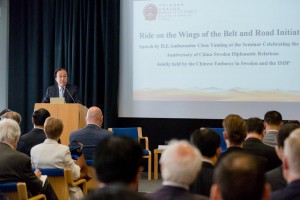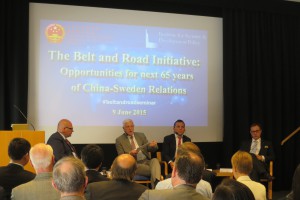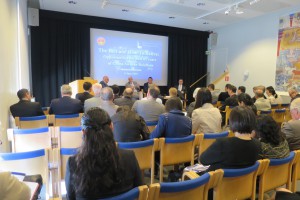When the Prince got married, what did the King say
Stockholm, June 14, (Greenpost)–Swedish Prince Carl Philip and Sofia Hellqvist got married on Saturday, 13 of June, 2015.
What did the King said at the wedding banquet?
H.M. the King’s speech to the married couple, 13 June 2015
To the Bride and Groom,
Finally, we are celebrating your wedding, Sofia and Carl Philip!
Today, we have witnessed your fine ceremony, heard the loving marriage vows you made to each other and listened to the joyous peals of bells which began the ceremony where ‘two shall become one flesh’.
And, my dear son, it is a particularly wonderful feeling to be able to celebrate your love for each other here, in the palace where you were born, dear Carl Philip.
Your mother and I are immensely happy to share this important day with you.
This is a moment you have both been longing for, have put so much energy into, and have planned so carefully to give it your personal touch and it will remain a very special memory all your lives, for the two of you and for all of us.
You have a wide range of interests, curiosities and abilities in many areas. You are a versatile, curious person, evidenced not least in the broad education you have acquired.
Following your military service as boat commander in Vaxholm’s Amphibious Battalion, you continued your training to become an officer. You have since risen through the ranks and are now a major.
You completed a course in graphic design and advertising at Forsberg skola. Your most recent achievement is a University Diploma in Agricultural and Rural Management, following your studies at the Swedish University of Agricultural Sciences in Alnarp.
You have succeeded in all these areas – not forgetting to include your artistic endeavours. For example, I am thinking of your celebrated photographic exhibition of the Botanical Gardens in Uppsala to commemorate the tercentenary of Carl Linnaeus, plus your time at Rhode Island School of Design in the USA.
The school held a competition to create the best new logo for Martha’s Vineyard Museum, which you won with your proposal that had been submitted under a pseudonym.
Your wide range of accomplishments is a link to interests and professions that have held an important place in our family for many generations. But you have forged your own path; and done so in your own way. You have worked hard and purposefully to achieve these excellent results – and as your father, I am very happy and proud.
You and I have many similarities. For example, we share a passion for sport, and have almost the same talents. Neither of us are shining stars on the tennis court, and we are hardly well-known for our ball skills either.
But put us on skis or round a running track and we are in our element. And I discovered these parallels fairly early on. One day – you were around eight or nine – I was about to head out for a run in the grounds at Drottningholm. Before I knew it, there you were – the laces of your running shoes already tied, waiting for me.
You wanted to come running too! So you did – and we ran many miles together. Of course, until the day came that you out-paced me!!
You have brilliantly taken on the role of my uncle, your godfather, Prince Bertil as a car lover. Not only is it fun, but it also has another claim: it gives me a cast-iron fatherly excuse to go to race events!
Your interest in food is extensive, going all the way from field to fork. We also share this passion, but so far it’s only me who has membership ‘plate’ number 17 in the Swedish Gastronomic Academy, as your godfather had before me.
I am also glad to share your commitment to forestry, agriculture and the environment, including the Stenhammar estate.
All this is also a great asset when you help me in representing Sweden. As Head of State, I want to thank you specially for the work you do serving this country.
I would also like to take this opportunity to highlight one of your personal qualities that everyone in Sweden recently got to see – your courage. It was incredibly courageous of you to talk about your reading and writing difficulties, and thereby raise awareness in this field. This means a lot to hundreds of thousands of others in the same situation, in particular children and young people, and not least to me.
You also demonstrated courage during a night dive where you saved a situation that could have ended very badly indeed. You and your dive group found yourselves in a cave, when vision suddenly became badly impaired. With your courage, knowledge and calm leadership, you took charge of the situation and linked arms with your colleagues to lead them out to safety. This incident is typical of you and your character. Carl Philip, you are a great role model for many people.
Sofia, I want to give you a very warm welcome into our family. We have got to know you as a warm, secure and open person. You are dedicated, enterprising and also very thoughtful. You show genuine care for other people.
You have worked as a volunteer and an aid worker in many African countries. It is very impressive how you set up Project Playground, which establishes important initiatives for children and young people in Cape Town.
You will also greatly benefit from all of this in your new role as a princess of Sweden. We are proud of you!
And when I think about it, Carl Philip and I also have a similarity here – that we have each succeeded in finding the perfect, most fantastic woman to share our lives.
It really is striking, just how much happiness and togetherness that you, Sofia and Carl Philip have found in each other. It is genuinely pleasing to see how you both bring out the best in each other. How you cooperate and complement each other, and how you support each other – in both the big and little things.
I would also like to warmly welcome the Hellqvist family into our family. Through Carl Philip’s and Sofia’s love for each other, new bonds of friendship are also formed.
To the Bride and Groom – today is the new beginning of your lives as husband and wife.
‘For this reason a man shall leave his father and mother and be joined to his wife, and the two shall become one flesh.’ As it is written.
From today, your loyalties should rest first and foremost to each other.
It is not always easy for a father to get used to that thought – and neither for your mother too, come to that.
But this is how it should be.
Carl Philip and Sofia: All of us here today can see the love and solidarity you have towards each other.
A fantastic atmosphere has been created both in the Royal Chapel and here in Vita havet, the White Sea Ballroom. Let this atmosphere sink in now, keep it with you always and think of it in your day-to-day lives as a married couple.
Follow Paul’s Epistle to the Romans, as we heard in the Royal Chapel today, to outdo one another in mutual respect.
To the Bride and Groom. Take care of each other and the joint life you are now beginning to build.
We, your family and friends, wish you the greatest of luck and prosperity!
I now ask everyone in the room to join me in congratulating the couple and giving a toast.
[All guests:] “De leve! Hurrah! Hurrah! Hurrah! Hurrah!”
Source Swedish Royal Family website.
Editor Xuefei Chen Axelsson




















